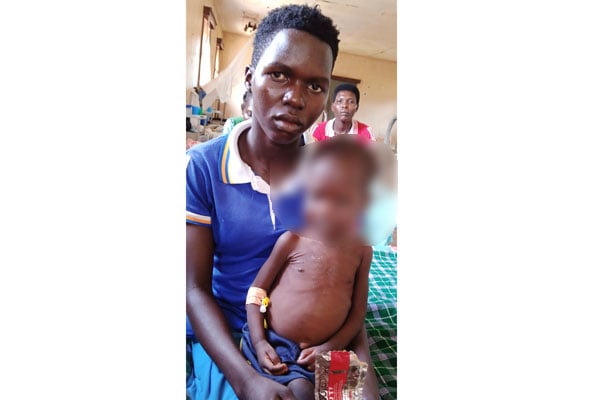
A health worker attends to a baby in West Nile last week. PHOTO/SCOVIN ICETA
On a sunny Wednesday afternoon, a group of 15 lactating mothers gather under a mango tree in Olemba Village, Ginyako Parish, Dranya Sub-county, in Koboko District.
One of the women is a lead mother, demonstrating to her peers how to use a small reading tape known as Mid-upper arm circumference (MUAC), with three colours of green, yellow and red to detect malnutrition.
Ms Never Brend, in her demonstration, says that when you measure your baby and the tape stops in the green colour, it means the child is feeding on a balanced diet and is healthy. She adds that when the colour is yellow, it is a sign that the baby is sliding into the malnutrition stage, and “we call the VHT (Village Health Team) to refer this baby to the health centre for treatment”.
When the tape stops in red, according to Ms Brend, it means the child is already malnourished and should be immediately referred to the hospital for quick medical attention.
MUAC is a measurement that allows health workers to quickly determine if a patient is acutely malnourished by measuring the circumference of a patient's arm at the midpoint between his/ her shoulder and elbow and whichever colour the measuring tape stops signifies whether that child is malnourished or not.
Ms Brend says that because of the training that they have been receiving from Unicef, the Swedish government, and the Ugandan government, they are now able to carry out the monthly measurements of their children and have learnt the importance of their children having a balanced diet.
“Before this programme came, people were eating the same type of foods over and over. They didn’t know which foods were energy-giving, or contained proteins, but with this programme, we can have a balanced diet. We have been also trained on how to create small gardens behind our houses to plant greens to balance our diet,” Ms Brend says.
Ms Hilda Kawuki, a Unicef official, says they have been able to introduce this simple measuring tape to over 13,000 households in the West Nile Sub-region in a bid to reverse the high rate of malnutrition that the region was facing.
“What was missing was the community screening level. We were finding a lot of children being diagnosed at the late stages and yet early screening is a preventative form of remedying malnutrition. When you screen them early, you can treat them or reverse malnutrition before it becomes severe,” Ms Kawuki explained during last week’s media tour of West Nile.
She added: “So we used to lose a lot of children to malnutrition because it would be detected when it was late, when the children were anaemic, hence increasing the maternal mortality rates in the region. We looked at the way of preventing the death rates from malnutrition by coming up with the family MUAC, which is a small tool but has solved so many problems. So, we prefer prevention.”
Statistics obtained from Arua Regional Referral Hospital show that on average, the facility admits 26 children monthly in the In-patient Therapeutic Care Unit while 30 children are admitted in the Out-patient Therapeutic Care Unit.
According to Ms Christine Nabwire, a health worker, this is a huge number of malnourished children.
TREATMENT TASK
Statistics obtained from Arua Regional Referral Hospital show that on average, the facility admits 26 children monthly in the In-patient Therapeutic Care Unit while 30 children are admitted in the Out-patient Therapeutic Care Unit.


